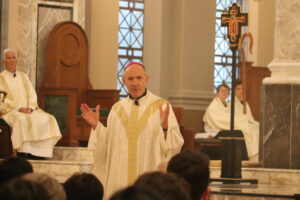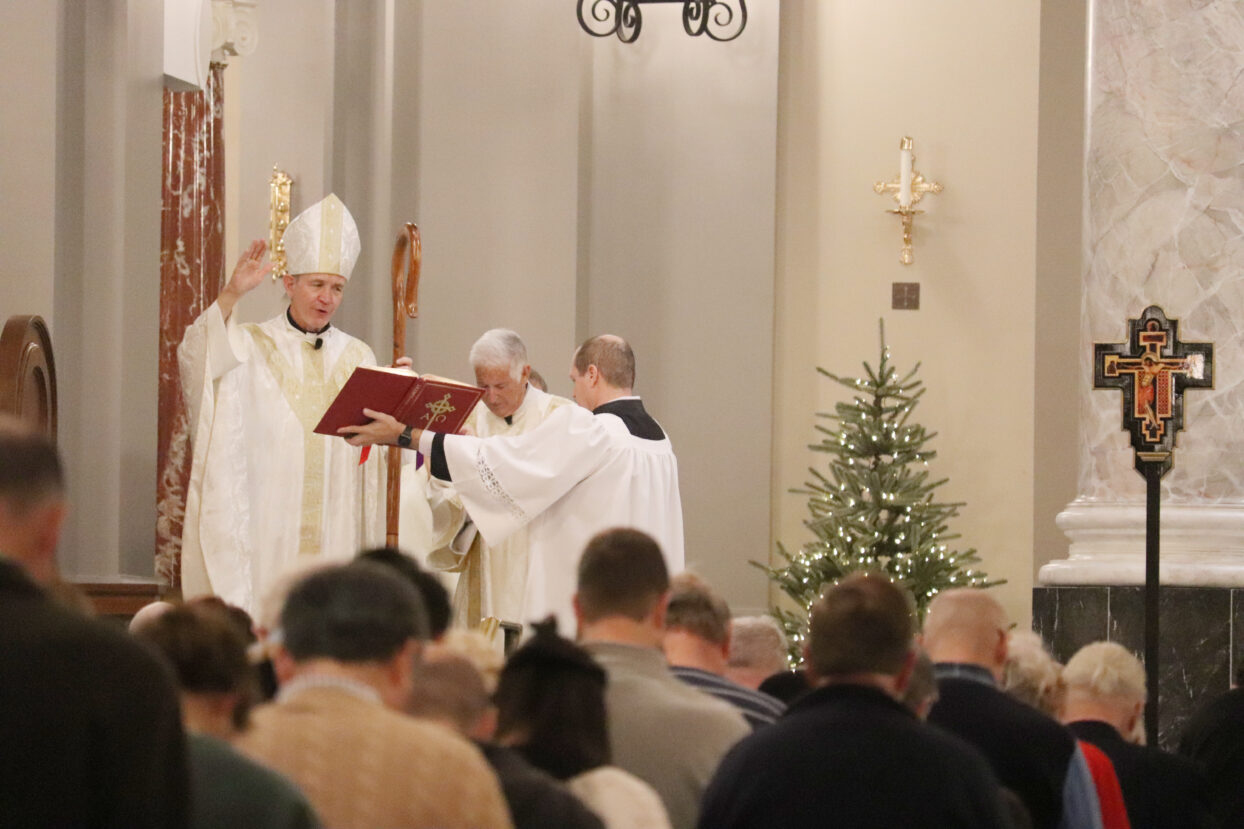Diocese of Knoxville opens participation in Jubilee Year 2025
By Gabrielle Nolan
On Christmas Eve, Pope Francis ushered in the Jubilee Year 2025 by opening the Holy Door of St. Peter’s Basilica in Rome prior to Mass.
With the theme “Pilgrims of Hope,” the Jubilee is the first ordinary Jubilee since Pope John Paul II declared the Great Jubilee of 2000.
Catholics around the world are called to participate in the Jubilee and increase their hope in the Lord. In particular, bishops were invited to place a special cross in their cathedrals to commemorate the Jubilee and invite the pilgrims of hope to prayer.
On Jan. 4, the vigil of the feast of the Epiphany, the Diocese of Knoxville opened its participation of the Jubilee Year with a Mass celebrated by Bishop Mark Beckman at the Cathedral of the Most Sacred Heart of Jesus.

A San Damiano cross commemorating the Jubilee Year was a prominent part of the Mass. (Photo Gabrielle Nolan)
The cross chosen to commemorate the Jubilee for the cathedral was a San Damiano cross, a replica of a Romanesque cross that St. Francis of Assisi prayed before when he received direction from God to rebuild His Church.
The San Damiano cross was placed at the front of the sanctuary near the Marian side, where it will remain for the rest of the Jubilee Year.
After processing into the cathedral, Bishop Beckman blessed and incensed the cross.
“Brothers and sisters, tonight we gather to celebrate the vigil of the great feast of the Epiphany,” Bishop Beckman said. “And tonight, as we celebrate the feast of the Epiphany, we all begin our participation in Pope Francis’ opening of the Holy Doors for a Year of Jubilee, which began on Christmas Eve when he opened the door of the Basilica of St. Peter, and he has continued to open holy doors. This year, the Jubilee is called a Pilgrimage of Hope, and we’re all invited to join in that great journey of hope to Christ the Lord. The Magi themselves were the beginning of that great journey, which we commemorate tonight.”
Bishop Beckman focused on the magi in his homily, sharing that these “mysterious travelers” have always fascinated him.
“St. Matthew doesn’t tell us how many magi there were,” he said. “We know the gifts are threefold: gold, frankincense, and myrrh. So, later tradition identified the number as three and eventually were given names and countries of origin. … Biblical commentators believe they may have come indeed from the area of the Middle East, what we would call Iran today, ancient Persia. A long tradition of astrologers who studied the heavens, the stars, looking for signs.”
The bishop highlighted that these Magi were not a part of God’s people, not “faithful Jews.”
“They were Gentiles, outsiders, people from way over yonder,” Bishop Beckman said.
He compared them with the original pilgrim, a man who traveled from the area of what is known today as Iraq: Abraham.
“Our father, Abraham, who was called by God to make a great journey with Sarah, his wife. And that first great journey, a great pilgrimage of its own, had something of trust and God in it. Someone once said Abraham had to be following God; we know that because he didn’t know where he was going. A pilgrim of hope, that God would be faithful to his call. That’s what Abraham was, and mysteriously these magi also become pilgrims of hope,” the bishop said.
He pondered the question: what would inspire people to leave behind their own backgrounds, religions, families, and lives in order to follow a star?
“If there was not something in their heart that was restless and empty, a longing for something that they had not yet experienced in life; it’s only when we’re unsatisfied or restless, and something about our current place is not enough, that we begin a great pilgrimage,” Bishop Beckman shared. “And so that restlessness of the human heart that they experienced opened them as they witnessed the rising star to begin that first great journey to the Christ Child.”
He remarked that when the Magi saw the infant with His mother, something transformed within them in that moment.
“It is for them a whole new beginning,” the bishop continued. “The longing of their heart must have been fulfilled when they recognized this vulnerable infant and knew that He was the answer that their hearts had been searching for their whole life long. A God who would become human, vulnerable like you and me… a God who evoked in them a transcendent awe.
“They fell down in homage and offered not only gold and frankincense and myrrh, but they offered themselves in love back to the one who had made a great pilgrimage to the Father to be with them, to offer unconditional human and divine love for each of them. They knew it. Their hearts were transformed. So open are they now to the impulse of God’s spirit, that the Lord will speak to them in a dream, and they will travel back to their home countries by a new route, another way.”
Bishop Beckman noted that on the opposite side of the spectrum were people like King Herod, who did not respond in hope.
“Think of Herod and the Scribes, the experts of the law gathered around him in Jerusalem, who are greatly disturbed by what they hear. No pilgrimage of hope for them, but only fear that they will lose what they have,” he said.

A San Damiano cross commemorating the Jubilee Year of Hope, standing behind Bishop Mark Beckman and near the altar at Sacred Heart Cathedral, will be in place during the Jubilee Year. (Photo Gabrielle Nolan)
“So, instead of opening their hearts and beginning a journey of hope, they close in on themselves and try to hold on to what they’ve already received, which is never enough. If you know anything about the King Herod of history, you know that he was willing to kill his own children to prevent them from following after on his throne. He was a cruel tyrant, and the Gospel story shows what he will do after the fact. And slaughtering the innocents is in character for Herod. A heart closed in on itself, not open to the mystery of love, eventually destroys not only itself but those around it,” he added.
The bishop then spoke of Pope Francis’ recent encyclical on the Sacred Heart of Jesus, which looked at the divine and human love of Jesus.
“[Pope Francis] talks about how the heart of Jesus is such a beautiful symbol because it opens to us as humans a way to understand the infinite love of God that’s poured out for each of us, that human-divine love that embraces us wherever we are on the journey of life. And that’s what inspires us to begin our own pilgrimage of hope,” Bishop Beckman remarked.
He said that the Jubilee is a time to “let the love of God free us from bondage” and commented on a merciful act of Pope Francis.
“Pope Francis opened a Holy Door for the first time in a prison in the city of Rome,” Bishop Beckman told the congregation. “I think about the prisoners who will walk through that door in faith and experience the unconditional love of God in their darkest moment of life.”
“That door is open for all of us this Jubilee Year. The door was open for us when the heart of Christ opened on the cross, and that’s why Pope Francis has invited cathedrals to have a special cross that would represent the open heart of God’s love in the heart of His Son during this Year of Jubilee. So, here in our cathedral church this year, we will be keeping our cross here, so when you enter the church you see that moment when the heart of Christ was fully open for you and for me,” he continued.
At the conclusion of his homily, the bishop invited the faithful to have a moment of reflection.
“The Lord is inviting us this year to let Him free us from whatever is holding us back from hope so that we can become channels of hope for our brothers and sisters who are still living in darkness and need to know the love of God. Let’s take a quiet moment now to ask the Lord to open our hearts anew during this great Jubilee Year, that we might be touched and transformed, as were the Magi,” he said.
Multiple Holy Doors have been opened around Rome. Besides the door at St. Peter’s Basilica, there are also doors at the Rebibbia Prison, the Basilica of St. John Lateran, the Basilica of St. Mary Major, and the Basilica of St. Paul Outside the Walls.
Several special events will take place during the Jubilee, such as the Jubilee of Teenagers, Jubilee of Young People, and Jubilee of Families, Children, Grandparents, and the Elderly.
The Jubilee Year will conclude during the Christmas season next December.
For more information, visit usccb.org/jubilee2025 or dioknox.org/jubilee.


Comments 2
What are the designated pilgrimage sites for the Jubilee Year 2025 in the Diocese of Knoxville, Tennessee?
Has our cathedral or another local church been designated as a pilgrimage site for purposes of the indulgence?
I read on usccb.org:
“…Those who cannot travel abroad, local bishops around the world can designate their cathedral or another church or sacred place for pilgrims to obtain the indulgence, the cardinal wrote, asking bishops to “take into account the needs of the faithful as well as the opportunity to reinforce the concept of pilgrimage with all its symbolic significance, so as to manifest the great need for conversion and reconciliation.”
https://www.usccb.org/news/2024/vatican-norms-jubilee-indulgence-include-pilgrimage-penance-service